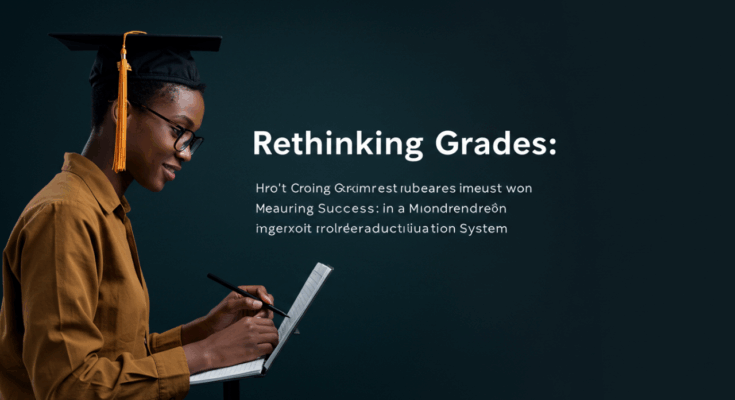In an era where artificial intelligence, remote work, and global challenges redefine success, the traditional grading system—rooted in letter grades and percentages—feels increasingly outdated. For over a century, schools have relied on A’s through F’s to measure student achievement, but this approach often prioritizes rote memorization and competition over deep understanding and personal growth. As we rethink education in 2025, it’s time to question: Do grades truly reflect success? This article delves into the limitations of conventional grading, explores innovative alternatives, and provides actionable strategies for educators, administrators, and families to foster a more holistic measurement of student progress. By shifting focus, we can create environments where learning thrives, mental health improves, and students are better prepared for real-world demands.
The Flaws in Traditional Grading
Historical Context and Core Mechanics
Traditional grading emerged in the 19th century as a way to standardize education in growing industrial societies. It typically involves assigning points for assignments, tests, and participation, then averaging them into a final letter grade or GPA. While this system provides a clear, quantifiable metric, it often reduces complex learning to simplistic scores. For example, a student might excel in creative projects but falter on timed exams, resulting in a mediocre grade that doesn’t capture their strengths.

Impacts on Student Motivation and Mental Health
One major drawback is the psychological toll. High-stakes grading can fuel anxiety and depression, with students viewing low marks as personal failures rather than opportunities for improvement. Research highlights how relentless pressure for perfect scores leads to sleep deprivation and burnout, exacerbating mental health issues. In fact, academic stress tied to grades is a primary contributor to rising rates of anxiety and even suicidal ideation among youth. On the success front, grades as external motivators can backfire, promoting surface-level learning where students cram for tests instead of retaining knowledge long-term. This misalignment means grades often correlate poorly with future career achievements, where skills like adaptability and collaboration matter more.
Limitations in Equity and Accuracy
Grading isn’t always fair. Factors like socioeconomic background, access to resources, or even teacher bias can skew results. Curved grading, where scores are adjusted based on class performance, pits students against each other, fostering competition over cooperation. Moreover, grades rarely account for effort or growth, discouraging those who start behind but improve significantly. In diverse classrooms, this can widen achievement gaps, as underrepresented students face additional barriers.
Why Rethink Grades Now?
Adapting to a Changing World
The modern workforce values competencies over credentials. Employers seek problem-solvers who can innovate and work in teams, not just high-GPA candidates. With rapid technological advancements, education must emphasize lifelong learning skills like critical thinking and resilience. Traditional grades, focused on compliance and memorization, fall short here. Rethinking them aligns education with real-world needs, preparing students for uncertainties like AI-driven job shifts.
Addressing the Mental Health Crisis
Post-pandemic, student well-being has become a priority. Studies show that grading systems contribute to heightened stress, with letter grades creating fear of failure that stifles risk-taking. Alternatives that reduce this pressure, such as gradeless approaches, have been linked to increased motivation and deeper engagement without sacrificing academic rigor. By measuring success through mastery rather than punishment for mistakes, schools can cultivate healthier mindsets.
Promoting Equity and Inclusivity
In a diverse society, equitable assessment ensures all students thrive. Traditional systems often disadvantage those with learning differences or from non-traditional backgrounds. Modern reforms aim to level the playing field, using methods that value multiple intelligences and cultural perspectives.
Exploring Alternative Measurement Methods
Competency-Based Education (CBE)
CBE shifts from time-based progression to mastery of skills. Students advance upon demonstrating proficiency, not after a fixed semester. For instance, in math, a student might need to solve real-world problems at an 80% accuracy level before moving on. This approach reduces stress by allowing flexible pacing and focuses on understanding over speed. Actionable tip: Teachers can implement CBE by breaking curricula into clear competencies, using rubrics for assessment, and providing multiple attempts for mastery.
Portfolio and Project-Based Assessments
Portfolios compile student work over time, showcasing growth through essays, projects, and reflections. This method highlights creativity and application, unlike one-off tests. In a science class, a portfolio might include lab reports, peer reviews, and a final presentation on environmental issues. Benefits include better knowledge retention and real-world relevance. To start, educators can guide students to curate digital portfolios using tools like Google Sites, with self-reflections on each piece.
Self and Peer Assessments with Feedback Loops
Empowering students to evaluate their own and peers’ work builds metacognition and accountability. In self-assessment, students rate their effort and understanding against criteria, fostering ownership. Peer reviews encourage constructive feedback, mirroring collaborative workplaces. Combined with teacher input, this creates balanced evaluations. Research supports that such methods enhance motivation and reduce reliance on external validation. Practical step: Use anonymous peer feedback forms in group projects, followed by discussions to refine skills.
Standards-Based Grading (SBG)
SBG evaluates against specific learning standards, not averages. A student might receive “proficient” in analysis but “developing” in communication, providing targeted insights. This system, adopted in various districts, lowers anxiety by emphasizing progress. Schools can transition by aligning report cards to standards and training staff on consistent rubrics.
Implementing Changes in Schools
Strategies for Teachers
Begin small: Replace one unit’s grading with a portfolio or SBG. Provide clear rubrics and frequent feedback to guide students. Professional development, like workshops on alternative assessments, is crucial. Track progress with student surveys to refine approaches.
School-Wide Reforms
Administrators can pilot programs in select grades, gathering data on outcomes like engagement and retention. Partner with organizations for resources, and involve stakeholders in planning. For example, a California school shifted to alternative grading, resulting in higher student satisfaction and fewer failures. Another model is Brown University’s Satisfactory/No Credit option, which allows flexibility without penalizing exploration.
Engaging Parents and Students
Communicate benefits through meetings and newsletters, addressing concerns about college admissions. Many universities now value holistic applications, including portfolios. Students can participate in goal-setting conferences, making them active partners in their evaluation.
Overcoming Challenges
Resistance and Logistics
Shifting paradigms faces pushback from habituated systems. Solutions include phased implementation and evidence-based advocacy, showing how alternatives improve equity. Logistically, update software for new reporting and train staff adequately.
Measuring Effectiveness
Without standard grades, how to gauge success? Use mixed methods: pre/post tests for knowledge, surveys for well-being, and longitudinal tracking for long-term outcomes. Challenges like subjectivity in rubrics can be mitigated with calibration sessions among teachers.
Policy and Scalability
At district levels, align with state standards while advocating for flexibility. Examples from 2025 show promise in elementary schools adopting growth-focused models, leading to enthusiastic learners.
Conclusion
Rethinking grades isn’t about eliminating accountability—it’s about redefining success to include growth, well-being, and real skills. By adopting alternatives like CBE and portfolios, we can build an education system that inspires rather than stresses. Educators and families: Start conversations today, pilot changes, and watch students flourish. The future of learning depends on it.
FAQ
What are the main problems with traditional grades?
They often cause stress, promote superficial learning, and fail to account for individual growth or equity issues.
How does competency-based education differ from traditional grading?
CBE focuses on mastering skills at one’s own pace, rather than timed averages, allowing for personalized progress.
Can alternative grading prepare students for college?
Yes, many colleges accept portfolios and holistic assessments, valuing demonstrated competencies over GPAs.
What if parents worry about motivation without grades?
Alternatives like self-assessment build intrinsic motivation, leading to sustained engagement without external pressure.
Are there real schools using these methods successfully?
Yes, examples include California districts with reduced failures and universities like Brown offering pass/fail options.
How to start implementing alternative assessments in a classroom?
Begin with one assignment using rubrics for feedback, gather student input, and scale based on results.



